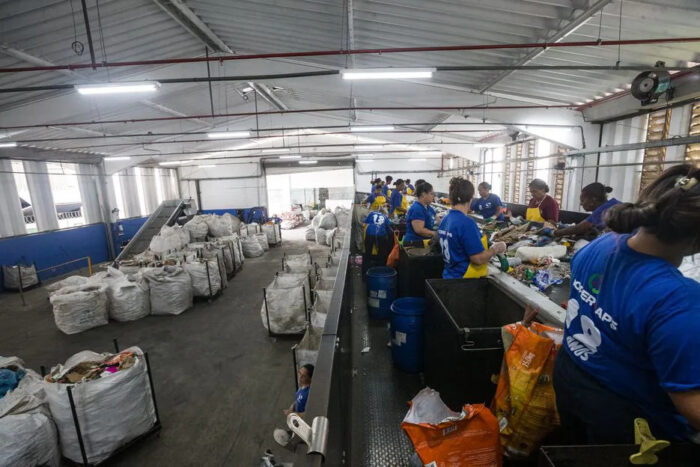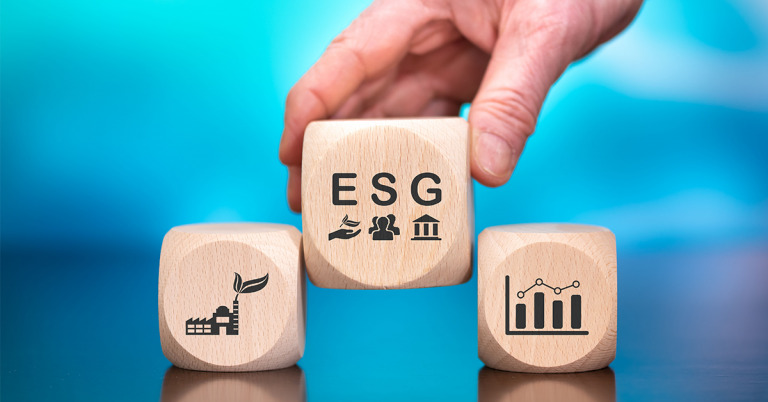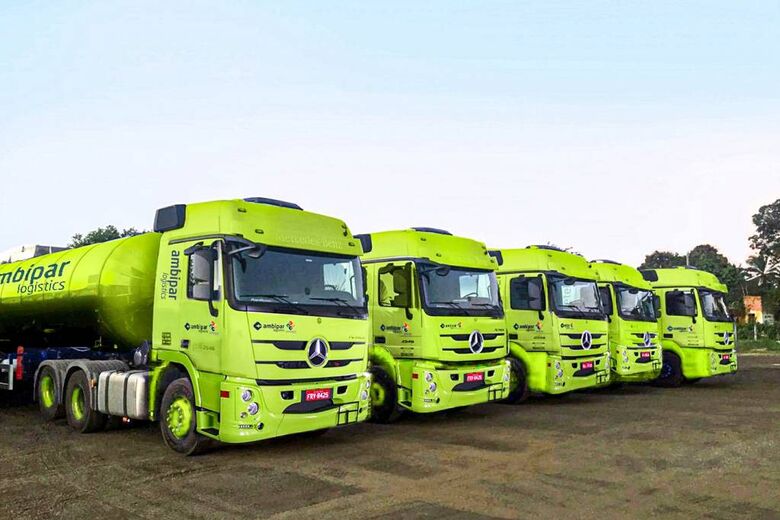Estadão by Juliana Domingos de Lima - 13/12/2023

By Writing Team
Posted in December 13, 2023

Cooperative for recycling in the Jurubatuba neighborhood, in the southern zone of São Paulo; certificate generates extra income for the collectors Photo: TABA BENEDICTO / ESTADÃO.
Brazil generates about 80 million tons of solid waste per year and recycles only 4%. Recent regulation boosts reuse.
The term “reverse logistics” may sound very technical, but it relates to a simple principle of environmental responsibility: the waste generated from what is produced, sold, and consumed needs to be collected and reused, or properly disposed of if it cannot be reused by the industry.
This disposal became mandatory in the country in 2010, with the National Solid Waste Policy, which established a “shared custody” of waste among companies, consumers, and the public sector. The implementation of this policy has been gaining strength more recently with the adoption of recycling credits, institutionalized by a federal government decree in 2022.
Brazil generates about 80 million tons of solid waste per year and recycles only 4%, according to data from the Brazilian Association of Public Cleaning and Special Waste Companies (Abrelpe). The rate is much lower than that of countries with similar income levels, such as Chile and South Africa, which recycle an average of 16% of their waste, according to the International Solid Waste Association (ISWA).
“Regulation is super important to accelerate the process because it brings this urgency. There is still much to be done,” says Maíra Pereira, executive director of Ambipar Environment, a company that works in the structuring of the recycling chain.
The certificates are an environmental compensation system, similar to carbon credits. In practice, instead of each company being directly responsible for the collection of the waste it produces, it has the option to buy credits to finance the collection of a quantity of recyclable material equivalent to the waste it generates.
The purchase of a certificate serves as a guarantee, before the public authorities, of the company’s compliance with the law and also generates extra income for the cooperatives of collectors who already perform this work. They are responsible for collecting 90% of all recyclable waste in the country, according to the EuReciclo company. This volume reached 1 million tons of materials in 2021, according to the Recycling Yearbook.

European Model
Used in Europe, the recycling credit started to be adopted in Brazil about five years ago, through the initiative of entities and companies, with the aim of facilitating the execution of reverse logistics, including the participation of micro and small businesses.
“It is one of the tools that can economically enable reverse logistics and recycling, and still have a social fund for the remuneration of operators,” says Ricardo Lopes Garcia, president of the management board of Instituto Giro.
The credits were initially applied within Fiesp (Federation of Industries of the State of São Paulo) and spread to other states such as Mato Grosso do Sul, Amazonas, and Rio Grande do Sul, until gaining national coverage with regulation by the federal government.
From there, managing entities were created, such as the Instituto Rever and Instituto Giro, authorized to issue certificates reliably and also promote the professionalization of the chain.
“Since the creation of the Fiesp reverse logistics system, we have already sold more than 250 thousand tons (of recyclable material) in the credit mode. Last year, which was the first full year of Rever operating the system, we exceeded 35 thousand tons,” says Paulo Petroni, president of Instituto Rever.
On average, the remuneration from Rever for the service provided by cooperatives of collectors in 2023 was R$ 180 per ton.
“The cooperative has revenue from the sale of the mass (of the collected material), which is paid by the recycler, but issues an additional invoice for the service. We recognize the urban cleaning service provided by the collector and pay a recycling credit in cash. It is the simplest compensation that can be made,” explains Petroni.
According to Telines Basilio, Carioca, president of the São Paulo recycling cooperative Coopercaps, the credits have indeed been increasing revenue. “We use part of this resource to pay the electricity bill, water bill. This reduces expenses, the net surplus ends up being larger, and we can distribute a more fair value to our members,” he explains. “Our monthly revenue cannot be exclusively derived from the separation and sale of the material; we need to create other revenues, and one of them is precisely the credit.”
But the challenges for informal collectors or small associations in all regions of the country to take advantage of this extra income are enormous. “The vast majority of associations and cooperatives have a productive layout that does not meet the entire volume collected, which decreases production and requires investment,” says Carioca. He also emphasizes that the overwhelming majority of collectors work informally.
Considering this difficulty, the professionalization of recycling cooperatives is one of the areas where Ambipar Environment and Instituto Giro have been active. “We formalize the situation of freelance collectors, bring them to a condition of issuing invoices, governance, productive efficiency, and greatly improve the supply conditions of these groups,” says Maíra Pereira, from Ambipar Environment.
According to the executive director, this professionalization journey has resulted in an increase in production from about 20 to 90 tons per month for cooperatives and an increase in income for collectors from a range of R$ 700 to R$ 2,500 to R$ 3,000.
In this system, the return of materials can also generate benefits for the end consumer. Those who take recyclable materials to one of Ambipar’s collection points get a credit in “tricoins,” a digital currency that can be converted into transport credits, on the electricity bill, in bookstores, or in a bank account.
Each type of material has its point count: one kilogram of plastic, for example, is equivalent to 100 tricoins, which in turn can be converted into R$ 0.35 on the Bilhete Único or other types of credit.
Is Recycling Enough?
Approved in 2022, the National Solid Waste Plan (Planares) aims to achieve a recycling rate of 48% by 2040. It also sets for 2024 the closure of landfills and controlled landfills.
According to the Abrelpe Solid Waste Panorama for 2022, 61% of the waste collected in Brazil continues to be sent to landfills, while 39% goes to dumps and controlled landfills. This latter percentage corresponds to 29.7 million tons with inappropriate disposal.
“We continue to bury material that could add value, could generate wealth for the country, and move the local economy of the communities where the cooperatives are,” says the president of Coopercaps.
The proper management of waste also has the potential to reduce greenhouse gas emissions. It is possible, for example, to reduce emissions in the atmosphere by recovering gases released in landfills or preventing their generation through the composting of organic waste.
The Abrelpe report estimates that meeting the Planares goals would avoid the emission of more than 30 million tons of carbon equivalent.
At the same time, experts argue that solving the waste problem requires action on other fronts, such as ecodesign. “We need to rethink the industry, consumption patterns. In the circular economy, recycling is the last stage, after you have reduced,” says Maíra Pereira, from Ambipar Environment.
“Recycling has an operational limit; no one will be able to recycle 100%. Not only because the material has a cycle – for example, paper cannot be recycled after a certain point – but also because of these various bottlenecks. We cannot bet all our chips on this,” says Ricardo Lopes Garcia, president of the management board of Instituto Giro.
For Garcia, there also needs to be a change in consumption habits and material separation, but it will not happen overnight. “It depends on education, awareness, making it easy for people to take the garbage to a specific location – it’s no use putting a voluntary drop-off point if there is no kind of incentive. In the circular economy, the consumer is our weakest link,” he says.
He considers that initiatives aimed at generating credits for consumers in the country are still incipient and specific, making it difficult to assess their effective results. Still, he is optimistic about the advances made since the past decade: “The numbers are still unknown; we don’t have an effective survey (of the recycling percentage). But from 2010 to now, the evolution has been gigantic and visible.”


